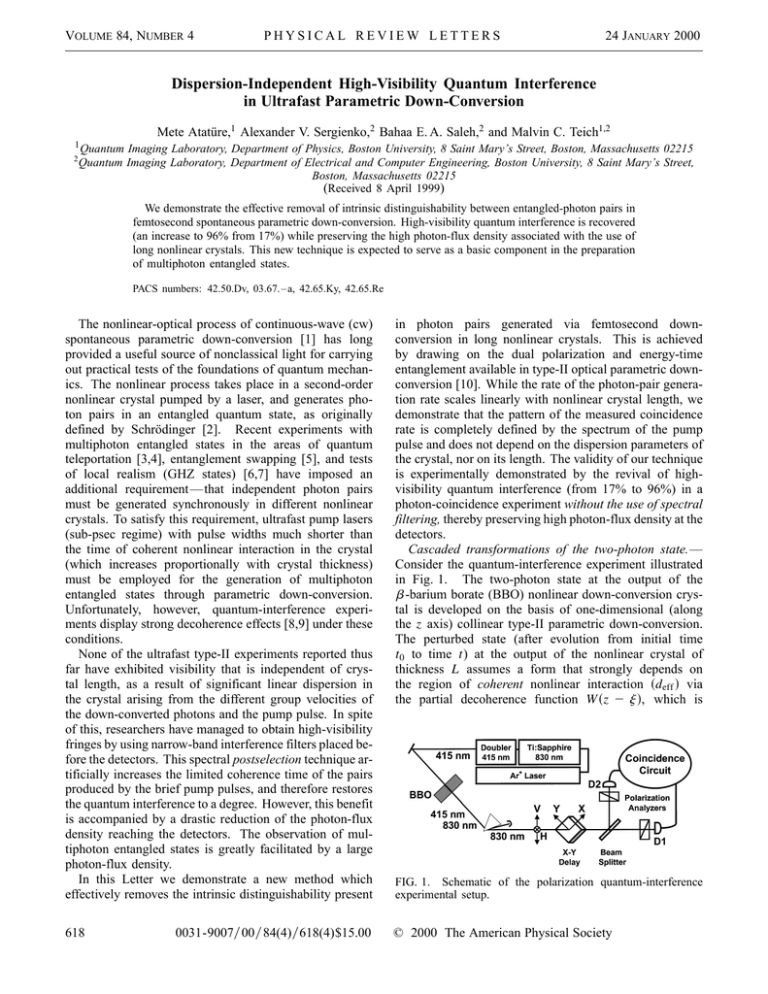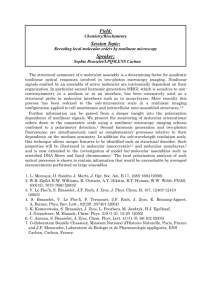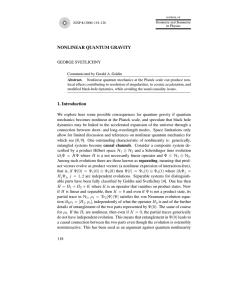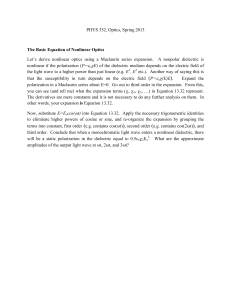Dispersion-Independent High-Visibility Quantum Interference in Ultrafast Parametric Down-Conversion
advertisement

VOLUME 84, NUMBER 4 PHYSICAL REVIEW LETTERS 24 JANUARY 2000 Dispersion-Independent High-Visibility Quantum Interference in Ultrafast Parametric Down-Conversion Mete Atatüre,1 Alexander V. Sergienko,2 Bahaa E. A. Saleh,2 and Malvin C. Teich1,2 1 2 Quantum Imaging Laboratory, Department of Physics, Boston University, 8 Saint Mary’s Street, Boston, Massachusetts 02215 Quantum Imaging Laboratory, Department of Electrical and Computer Engineering, Boston University, 8 Saint Mary’s Street, Boston, Massachusetts 02215 (Received 8 April 1999) We demonstrate the effective removal of intrinsic distinguishability between entangled-photon pairs in femtosecond spontaneous parametric down-conversion. High-visibility quantum interference is recovered (an increase to 96% from 17%) while preserving the high photon-flux density associated with the use of long nonlinear crystals. This new technique is expected to serve as a basic component in the preparation of multiphoton entangled states. PACS numbers: 42.50.Dv, 03.67. – a, 42.65.Ky, 42.65.Re The nonlinear-optical process of continuous-wave (cw) spontaneous parametric down-conversion [1] has long provided a useful source of nonclassical light for carrying out practical tests of the foundations of quantum mechanics. The nonlinear process takes place in a second-order nonlinear crystal pumped by a laser, and generates photon pairs in an entangled quantum state, as originally defined by Schrödinger [2]. Recent experiments with multiphoton entangled states in the areas of quantum teleportation [3,4], entanglement swapping [5], and tests of local realism (GHZ states) [6,7] have imposed an additional requirement—that independent photon pairs must be generated synchronously in different nonlinear crystals. To satisfy this requirement, ultrafast pump lasers (sub-psec regime) with pulse widths much shorter than the time of coherent nonlinear interaction in the crystal (which increases proportionally with crystal thickness) must be employed for the generation of multiphoton entangled states through parametric down-conversion. Unfortunately, however, quantum-interference experiments display strong decoherence effects [8,9] under these conditions. None of the ultrafast type-II experiments reported thus far have exhibited visibility that is independent of crystal length, as a result of significant linear dispersion in the crystal arising from the different group velocities of the down-converted photons and the pump pulse. In spite of this, researchers have managed to obtain high-visibility fringes by using narrow-band interference filters placed before the detectors. This spectral postselection technique artificially increases the limited coherence time of the pairs produced by the brief pump pulses, and therefore restores the quantum interference to a degree. However, this benefit is accompanied by a drastic reduction of the photon-flux density reaching the detectors. The observation of multiphoton entangled states is greatly facilitated by a large photon-flux density. In this Letter we demonstrate a new method which effectively removes the intrinsic distinguishability present in photon pairs generated via femtosecond downconversion in long nonlinear crystals. This is achieved by drawing on the dual polarization and energy-time entanglement available in type-II optical parametric downconversion [10]. While the rate of the photon-pair generation rate scales linearly with nonlinear crystal length, we demonstrate that the pattern of the measured coincidence rate is completely defined by the spectrum of the pump pulse and does not depend on the dispersion parameters of the crystal, nor on its length. The validity of our technique is experimentally demonstrated by the revival of highvisibility quantum interference (from 17% to 96%) in a photon-coincidence experiment without the use of spectral filtering, thereby preserving high photon-flux density at the detectors. Cascaded transformations of the two-photon state.— Consider the quantum-interference experiment illustrated in Fig. 1. The two-photon state at the output of the b-barium borate (BBO) nonlinear down-conversion crystal is developed on the basis of one-dimensional (along the z axis) collinear type-II parametric down-conversion. The perturbed state (after evolution from initial time t0 to time t) at the output of the nonlinear crystal of thickness L assumes a form that strongly depends on the region of coherent nonlinear interaction 共deff 兲 via the partial decoherence function W共z 2 j兲, which is 618 © 2000 The American Physical Society 0031-9007兾00兾84(4)兾618(4)$15.00 FIG. 1. Schematic of the polarization quantum-interference experimental setup. VOLUME 84, NUMBER 4 PHYSICAL REVIEW LETTERS 24 JANUARY 2000 localized about an arbitrary position j in the nonlinear crystal [9]: i Z t 0 共2兲 Z 0 共2兲 jCj 典 ⬃ j0典 2 dt x dz W共z 2 j兲 h̄ t0 2L 共2兲 3 关Ep共1兲 共t 0 , z兲es Ês共2兲 共t 0 , z兲ei Êi 共t 0 , z兲 1 H.c.兴 j0典 . (1) Here x 共2兲 is the second-order susceptibility of the nonlinear medium; ej is the unit vector denoting the polarization 共2兲 state of the jth field Êj 共t 0 , z兲; the subscripts p, s, and i represent the pump, signal, and idler, respectively; the pump field is assumed to be a propagating classical transform-limited pulse whose amplitude is slowly varying: s µ ∂ z 共1兲 0 Ep 共t , z兲 苷 Ip t 0 2 exp关i共kp0 z 2 vp0 t 0 兲兴 . (2) yp The quantity Ip 共t 0 , z兲 repeats the intensity profile of the pump at time t 0 and position z along the propagation axis with a full width at half maximum (FWHM) denoted tp . Because of the characteristic of our laser beam, weq specifically chose it to have a Gaussian p z form, Ip 共t 0 , z兲 苷 I0 exp关2共t 0 2 yp 兲2 兾2s 2 兴 with p s 苷 tp 兾共2 ln2 兲, though the theory is more general and can accommodate any pulse shape. The central wave number, carrier frequency, and group velocity of the pump (at the carrier frequency inside the nonlinear crystal) are denoted in Eq. (2) by kp0 , vp0 , and yp , respectively. The explicit form of W共z 2 j兲 is taken to be a half-Gaussian with argument 共z 2 j兲 and width deff ; its magnitude decreases with increasing argument as a consequence of the effective gradual separation of the pump pulse from the down-converted fields in the nonlinear crystal arising from linear dispersion. This function reflects the distinguishability not only between the down-converted photons of each pair but also between pairs born at different locations as the femtosecond pump pulse traverses the nonlinear crystal. We now consider the timing diagram shown in Fig. 2 in conjunction with the schematic of our experimental apparatus presented in Fig. 1. Once an orthogonally polarized photon pair in the laboratory polarization basis [H (horizontal), V (vertical)] is generated at time t0 around position j, it propagates through the nonlinear downconversion crystal, acquiring a relative time delay fj imparted by the birefringence of the nonlinear crystal. The two-photon state in the 共H, V 兲 basis, 共2兲 jCj 典 ⬃ jV 典t0 jH典t0 1fj , (3) then propagates through a polarization delay line made of birefringent material (such as crystalline quartz) oriented so that its fast X (slow Y ) axis is rotated by 45± with respect to the H 共V 兲 polarization axis (projection and optical-path-delay operations are displayed separately in FIG. 2. A cross-polarized photon pair generated in the vicinity of position j within the nonlinear down-conversion crystal acquires a relative time delay fj . These photons are projected to a new basis 共X, Y 兲 that is tilted by 45± with respect to the original basis 共H, V 兲, and the Y -projected photon experiences a relative optical-path delay t with respect to the X-projected photon as a result of the birefringence of the delay element. (Projection and optical-path delay operations are displayed separately for clarity.) Although there appear to be four possible configurations that the photon pair can assume before arriving at the beam splitter (far right), the bottom two (dotted) vanish because of their coefficients. The remaining two contributions (solid) preserve their relative delay fj , so that the interfering terms are the XX and YY terms with a delay t, whatever the value of fj . Fig. 2 for clarity). As a result of the projection, the two-photon state in the rectilinear 共X, Y 兲 basis becomes 共2兲 jCj 典 ⬃ 共jX典t0 1 jY 典t0 兲 共jX典t0 1fj 2 jY 典t0 1fj 兲 . (4) Finally, the longitudinal optical-path delay t along the Y axis with respect to the X axis gives rise to 共2兲 jCj 典 ⬃ 共jX典t0 jX典t0 1fj 2 jY 典t0 1t jY 典t0 1fj 1t 兲 1 共jY 典t0 1t jX典t0 1fj 2 jX典t0 jY 典t0 1fj 1t 兲 , (5) which is illustrated at the far right of Fig. 2. This then arrives at a nonpolarizing beam splitter, as shown in Fig. 1, which injects photons into the two arms of the polarization interferometer (denoted in the following equations as subscripts 1 and 2). The polarization analyzers at the ends of the arms, being the final elements in the polarization interferometer, transform the two-photon state once more, via the operator P̂ ⬅ jQ典1 jQ典2 2 具Qj1 具Qj, which is constructed in the polarization analyzer states Q1 and Q2 . Taking account of the transformations described above, one can calculate the two-photon detection probability amplitude 共1兲 共1兲 共2兲 Aj 共t1 , t2 兲 苷 具0jÊ1 Ê2 jCj 典 , (6) where t1 共t2 兲 denotes the event registration time at the detector located at the first (second) arm of the interferometer. For an arbitrary region about the position j in the crystal, Eq. (6) takes the explicit form [9] s µ ∂ j L Aj 共T , t兲 ⬅ Aj 共t1 , t2 兲 ⬃ Ip T 2 t2 D yp ∂ µ t 3 W共t兲rect关2L,0兴 1j D 3 exp关i共kp0 j 2 vp0 T 兲兴 , (7) 619 VOLUME 84, NUMBER 4 PHYSICAL REVIEW LETTERS where T 苷 共t1 1 t2 兲兾2, t 苷 共t1 2 t2 兲, L苷 关1兾yp 2 共1兾2兲 共1兾ys 1 1兾yi 兲兴, and D 苷 共1兾yi 2 1兾ys 兲. The function rect关2L,0兴 共z兲 has a unity value when its argument is in the range 关2L, 0兴 and vanishes otherwise, and W共t兲 is the partial decoherence function discussed above. When we carry out the above-described set of transformations, the rotated optical delay line causes multiple possibilities of coincidence detection, thereby yielding an overall two-photon detection probability amplitude that is the superposition of these possibilities. However, as a consequence of the cascaded transformations, the possibilities originating from the two right-most terms in Eq. (5) (shown as dotted in Fig. 2) vanish, leaving only two surviving terms that contribute to the overall two-photon amplitude: R共u1 , u2 , t兲 苷 Gp 共0兲 Z 0 2L1deff 24 JANUARY 2000 ∂ µ ∂ µ p p Bj,t 共T , t兲 ⬃ cos 2 u1 cos 2 u2 Aj 共T , t兲 4 4 µ ∂ µ ∂ p p 2 sin 2 u1 sin 2 u2 4 4 3 Aj 共T 1 t, t兲 . (8) Finally, using Eq. (8) in the coincidence-count rate equation [1] provides R共t兲 苷 Z 0 dj 2L1deff Z ` 2` Z ` 2` dT dtjBj,t 共T , t兲j2 , (9) from which we determine the explicit form of the coincidence-count rate at the detectors, as a function of polarization-analyzer angles 共u1 , u2 兲 and optical-path relative delay time 共t兲, to be ∑ dj F共j兲 共cos2 q1 cos2 q2 1 sin2 q1 sin2 q2 兲 ∏ Gp 共t兲 0 cos共vp t兲 , 2 2共sinq1 sinq2 cosq1 cosq2 兲 (10) Gp 共0兲 q R` where Gp 共t兲 苷 2` dt Ip 共t兲Ip 共t 1 t兲 and qi ⬅ a Glan-Thompson polarization analyzer, and thence to p兾4 2 ui , i 苷 1, 2. All of the j-dependent terms in a convex lens for focusing onto an actively quenched Eq. (10) are collected in the function F共j兲 so that the Peltier-cooled avalanche photodiode photon-counting interference term (in square brackets) is generation-region detector. The detector event registrations were conveyed independent. This reflects the successful liberation of to a coincidence circuit with a 3 ns coincidence-time entangled photon pairs from any influence of dispersion window. Corrections for accidental coincidences were not associated with the nonlinear crystal which results in the necessary. width of the quantum-interference pattern being solely Discussion.—The experimental data (solid squares) determined by the pump-pulse duration tp . illustrated in the insets of Fig. 3 display the coinciQuantum-interference experiments with the new casdence rates (CR) as a function of polarization-analyzer caded-transformation state.—Experiments were carried angle u when u1 is fixed at 0±. Coincidence patout using the experimental arrangement shown in Fig. 1. 2 terns are shown for two representative relative opticalAn actively mode-locked Ti:sapphire laser (pumped by path delays: 296 fsec (left inset) and 0 fsec (right a cw Ar-ion laser) emitted pulses of light at 830 nm. inset). The visibility of the coincidence pattern, This radiation was frequency doubled to provide 80 fsec V 苷 共CRmax 2 CRmin 兲兾共CRmax 1 CRmin 兲, at 0 fsec pulses (FWHM) at lp 苷 415 nm, with a repetition rate delay turns out to be 96%, which is just a hair short of 82 MHz and an average power of 15 mW. of the theoretical maximum of 100%. This is to be This sequence of femtosecond pulses was delivered to compared with the rather anemic visibility of 17% that a BBO crystal, where it underwent type-II spontaneous was observed in a similar configuration using a nonparametric down-conversion in a collinear degenerate rotated polarization delay line [9] (time-delay fringes 共v10 苷 v20 苷 vp0 兾2兲 configuration. The collinear beam of and polarization-rotation fringes are interchangeable, as down-converted photons was selected by a 2.5 mm circular has recently been established for femtosecond downaperture located about 7 cm beyond the crystal. After the conversion [11]). residual pump pulses were separated from the signal Coincidence patterns such as the representative ones and idler beams using a fused-silica dispersion prism, shown in the insets were collected for various values of the down-converted photons were sent through the first the relative optical-path delay t. The open squares in the stage of the cascaded-transformation apparatus which was main plot of Fig. 3 represent the maximum and minimum composed of a birefringent material (crystalline quartz) values of the coincidence rate (connected by a vertical whose fast axis was oriented at 45± with respect to the dashed line) for various values of t. The coincidence-rate 共H, V 兲 laboratory coordinate system. Relative optical visibility is seen to decrease as t deviates from 0 fsec. delay was introduced by changing the thickness of the The width of the coincidence-rate pattern, which is about birefringent material. The down-converted photons con80 fsec, is determined solely by the pump-pulse duration tinued to a nonpolarizing beam splitter. The light at each and demonstrates a crystal-dispersion-independent profile output port of the beam splitter was then directed toward 620 VOLUME 84, NUMBER 4 PHYSICAL REVIEW LETTERS 24 JANUARY 2000 Note added in proof.—Since completing this work, a recently published paper [12] describing an experiment that achieves a visibility of 64% using a different technique has come to our attention. FIG. 3. Maxima and minima (open squares) of coincidencerate quantum-interference patterns plotted as a function of relative optical-path delay time t. Each pair of data points (connected by a dashed vertical line) corresponds to the maximum and minimum coincidence rates 共CR, sec21 兲 obtained from a polarization experiment at a particular value of t (examples are shown in the insets) in which the angle u2 of the second polarization analyzer is varied while u1 is fixed at 0±. The visibility of the interference pattern is measured to be 96% at 0 fsec relative path delay and the width of the path-delay interference pattern nicely reveals the 80 fsec pump-pulse duration used in these experiments. This experiment was conducted using a 3 mm thick BBO crystal. that remains identical for different thicknesses of the nonlinear down-conversion crystal. To conclude, we have successfully co-opted the dual energy time and polarization entanglement inherent in type-II parametric down-conversion to implement a new scheme for eliminating the effects of decoherence in femtosecond parametric down-conversion. Despite our use of long nonlinear crystals, which permits high photon-flux densities to be obtained, we have obtained a high-visibility quantuminterference pattern without the use of spectral filtering. We expect that this new technique will find use in a range of quantum-optics applications. We are grateful to Bradley M. Jost and Jan Peřina, Jr. for useful discussions. This work was supported by the National Science Foundation and the Boston University Photonics Center. [1] D. C. Burnham and D. L. Weinberg, Phys. Rev. Lett. 25, 84 (1970); J. Peřina, Z. Hradil, and B. Jurčo, Quantum Optics and Fundamentals of Physics (Kluwer, Boston, 1994); L. Mandel and E. Wolf, Optical Coherence and Quantum Optics (Cambridge, New York, 1995), Chap. 22. [2] E. Schrödinger, Naturwissenschaften 23, 807 (1935); 23, 823 (1935); 23, 844 (1935) [translation in Quantum Theory and Measurement, edited by J. A. Wheeler and W. H. Zurek (Princeton University Press, Princeton, NJ, 1983)]. [3] C. H. Bennett, G. Brassard, C. Crépeau, R. Jozsa, A. Peres, and W. Wootters, Phys. Rev. Lett. 70, 1895 (1993); D. Boschi, S. Branca, F. De Martini, L. Hardy, and S. Popescu, Phys. Rev. Lett. 80, 1121 (1998). [4] D. Bouwmeester, J.-W. Pan, K. Mattle, M. Eibl, H. Weinfurter, and A. Zeilinger, Nature (London) 390, 575 (1997). [5] J.-W. Pan, D. Bouwmeester, H. Weinfurter, and A. Zeilinger, Phys. Rev. Lett. 80, 3891 (1998). [6] D. M. Greenberger, M. A. Horne, and A. Zeilinger, in Bell’s Theorem, Quantum Theory and Conceptions of the Universe, edited by M. Kafatos (Kluwer, Dordrecht, The Netherlands, 1989); D. M. Greenberger, M. A. Horne, A. Shimony, and A. Zeilinger, Am. J. Phys. 58, 1131 (1990). [7] D. Bouwmeester, J.-W. Pan, M. Daniell, H. Weinfurter, and A. Zeilinger, Phys. Rev. Lett. 82, 1345 (1999). [8] G. Di Giuseppe, L. Haiberger, F. De Martini, and A. V. Sergienko, Phys. Rev. A 56, R21 (1997); W. P. Grice, R. Erdmann, I. A. Walmsley, and D. Branning, Phys. Rev. A 57, R2289 (1998); W. P. Grice and I. A. Walmsley, Phys. Rev. A 56, 1627 (1997); T. E. Keller and M. H. Rubin, Phys. Rev. A 56, 1534 (1997); J. Peřina, Jr., A. V. Sergienko, B. M. Jost, B. E. A. Saleh, and M. C. Teich, Phys. Rev. A 59, 2359 (1999). [9] M. Atatüre, A. V. Sergienko, B. M. Jost, B. E. A. Saleh, and M. C. Teich, Phys. Rev. Lett. 83, 1323 (1999). [10] T. B. Pittman, Y. H. Shih, A. V. Sergienko, and M. H. Rubin, Phys. Rev. A 51, 3495 (1995); Y. H. Shih and A. V. Sergienko, Phys. Lett. A 191, 201 (1994). [11] A. V. Sergienko, M. Atatüre, Z. Walton, G. Jaeger, B. E. A. Saleh, and M. C. Teich, Phys. Rev. A 60, R2622 (1999). [12] D. Branning, W. P. Grice, R. Erdmann, and I. A. Walmsley, Phys. Rev. Lett. 83, 955 (1999). 621







